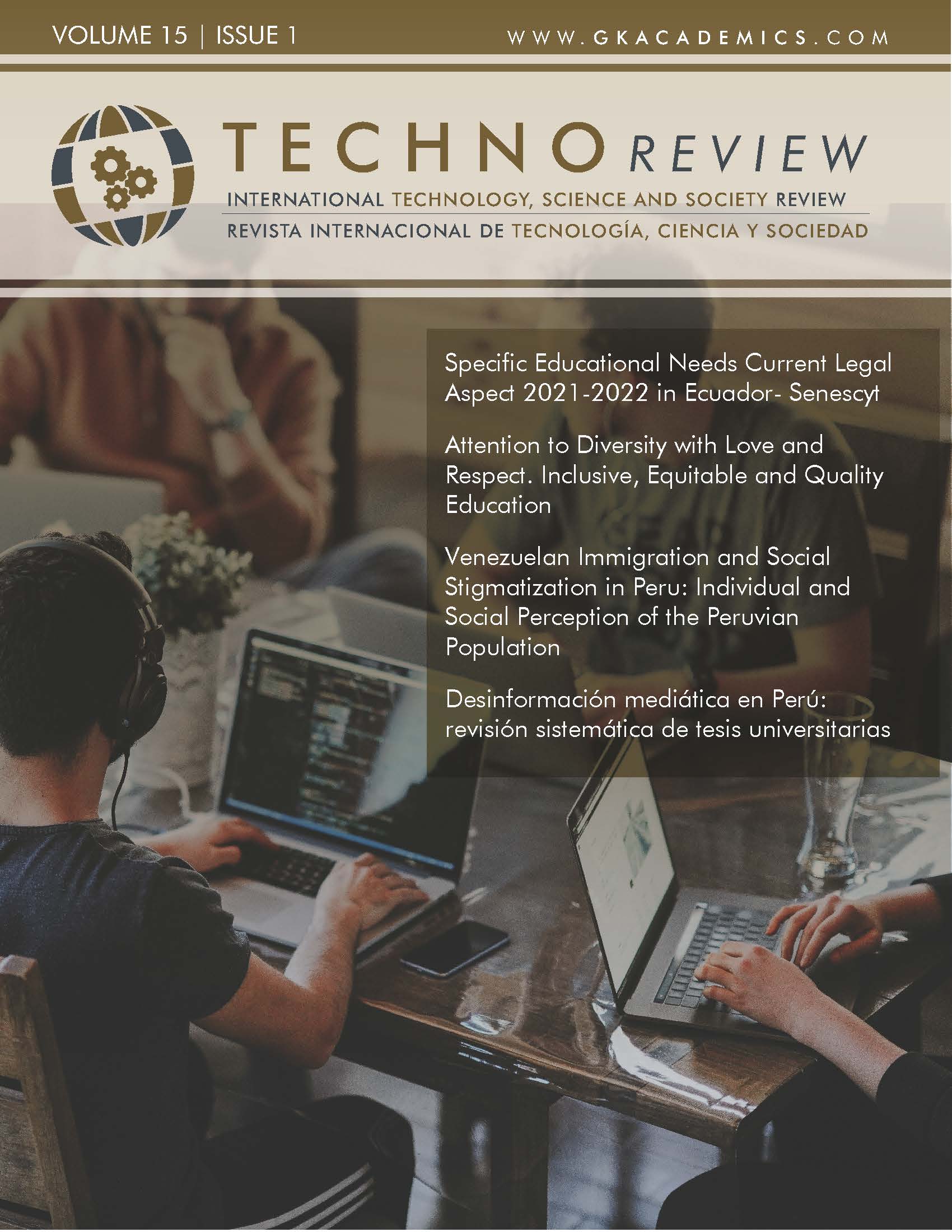Challenges of the black communities; the conservation of the Santiago Cayapas river commune
DOI:
https://doi.org/10.37467/revtechno.v15.5112Keywords:
Palenque, Slaves, Afro-descendant, Deterritorialization, Wood industry, AGROINDUSTRYAbstract
This article addresses the case of Afro-descendants in the Rio Santiago Cayapas Commune, Ecuador. Chapter I contextualizes Esmeraldas within the Chocó Biogeographic region. Chapter II analyzes the history from African slaves to the resistance stronghold. Chapter III explores how the resource-rich Rio Santiago Cayapas Commune faces state-driven displacement, logging industry, oil palm agriculture, and mining, prioritizing resource exploitation, impacting local communities. Logging, oil palm, and mining lead to deforestation, territory loss, conflicts, and environmental degradation, straining life in the Rio Santiago Cayapas Commune.
References
Aizaga, M. (1988). La vialidad y su importancia para el desarrollo y la seguridad nacional. Individual research work. Quito, Pichincha, Ecuador: IAEN.
Arroyo, V. (October 2019). Oil palm and deterritorialization in the Santiago Cayapas River Commune. Quito, Pichincha, Esmeraldas: FLACSO ANDES.
Chica, C. (FEBRUARY 26, 2010). ECOPORTAL. Retrieved October 7, 2019, from ECOPORTAL: https://www.ecoportal.net/temas-especiales/biodiversidad/el_choco_biogeografico_un_tesoro_de_la_naturaleza/
Escobar, A. (2008). Territories of Difference: Place, movements, life, networks. Popayán: Duke University Press.
Ferreira, R., & Seijas, T. (2018). AFRO-LATIN AMERICAN STUDIES AN INTRODUCTION (Vol. 1). (CLACSO, Ed., & J. Benseñor, Trad.) Ciudad Autónoma de Buenos Aires, Buenos Aires, Argentina: Latin American Council of Social Sciences. Retrieved November 29, 2019
García, J. (December 12-13, 2011). ON THE OTHER SIDE OF THE LINE. Encuentro internacional de reflexión y participación. Quito, Pichincha, Ecuador: Editorial Universitaria Abya-Yala.
García, J. (2022). Cimarronaje en el Pacífico Sur. Quito: Abya - Yala.
INEC. (2010). Results of the 2010 Census of Population and Housing in Ecuador. Quito: Esmeraldas Provincial Fascicle.
Jordán, F. (2003). Agrarian reform in Ecuador. In Proceso agrario en Bolivia y América Latina (pp. 285-317). La Paz: CIDES-UMSA, Posgrado en Ciencias del Desarrollo Rural.
Morrone, J. J. (2002). SYNTHETIC PRESENTATION OF A NEW BIOGEOGRAPHIC SCHEME FOR LATIN AMERICA AND THE CARIBBEAN. Proyecto de Red Iberoamericana de Biogeografía y Entomología Sistemática PRIBES 2002. C. COSTA, S. A. VANIN, J. M. LOBO & A. MELIC (Eds.), 10.
Mvengou, P. R. (2018). Issue 73, September-December, 2018. Cuicuilco Revista de Ciencias Antropológicas, 211-232.
Olmedo, B. (2006). THE SEPARATION OF PANAMA FROM COLOMBIA. MYTHS AND FALSEHOODS. Redalyc, 93-118.
Oca Rojas, Y. M., Silupu, W. M. C., Romero, R. M., Jonathan, C. T., & Bastidas, C. B. (2020). Information technologies for the formation of socio-productive networks: Theorical reflections. RISTI - Revista Iberica De Sistemas e Tecnologias De Informacao, 2020(E31), 151-160.
Parra, M. (2016). A LOOK AT THE ECONOMIC DYNAMICS OF CHOCÓ DURING 2016 FROM THE CHAMBER OF COMMERCE. Study, Chamber of Commerce of Chocó, Quibdó. Retrieved October 11, 2019
Rueda, R. (2019). DE ESCLAVIZADOS A COMUNEROS; CONSTRUCCIÓN DE LA ETNICIDAD NEGRA EN ESMERALDAS, SIGLOS XVIII-XIX. Quito: Universidad Andina Simón Bolívar, Sede Ecuador, UASB.
Suárez, I. (2011). The Darien Province and the Isthmus of Panama: Centuries at the heart of disputes over the expansion of capitalism. Anuario de Historia Regional y de las Fronteras, Volume 16, 17-50.
Wasserstrom, R., & Southgate, D. (2013). Deforestation, land reform and oil development in Ecuador, 1964 - 1994. Natural Resources, 34-44.
Wiliams, E. (2011). Capitalism and Slavery. Spain: Traficante de Sueños.
Downloads
Published
Issue
Section
License
Copyright (c) 2023 VÍCTOR MANUEL ARROYO QUIÑONEZ, MARÍA ELIZABETH CANCHINGRE BONE, SARA ELIZABETH TENORIO SEGURA, ENMA ELENA ESPINOZA ECHEVERRÍA

This work is licensed under a Creative Commons Attribution-NoDerivatives 4.0 International License.
All articles are published under an Attribution-NoDerivatives 4.0 International (CC BY-ND 4.0) license. Authors retain copyright over their work.

